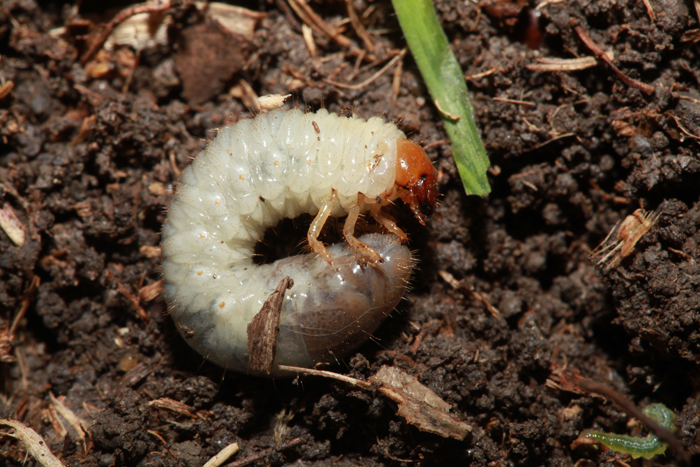As winter ends the good earth beckons. If you need proof, just listen this weekend. Like rattling sabers, you’ll hear gardeners everywhere dragging their spades, mattocks and hoes from storage. It’s an inevitable ritual of spring.
Just as inevitably, many gardeners will gasp as their thoughts of seed packets are interrupted by the sight of glistening white grubs in the newly turned soil.
White grubs are the immature life stage of the June beetle and its relatives. And as most Texas gardeners know, white grubs are not good. After all, grubs are one of those pests pictured on bags of insecticide at the local Home Depot, so they must be bad–right? Well yes, sort of.
The real question is whether we need to treat our gardens and lawns now to kill lawn-eating grubs? The answer is no. White grubs present in lawns (and many of those in garden beds) are almost always one of two species of scarab beetle known as the June beetle and the masked chafer. Both species can be damaging to turf in late summer, though feeding during the winter and spring is insignificant. The grubs we turn over in the spring garden are essentially in hibernation. They remain in a non-feeding state until May, when they undergo pupation before emerging from the ground as an adult in June and July.
As alarming as these juicy springtime grubs appear, they do little harm to plants in the spring. The harm comes between July and October after this spring’s June beetles have laid their eggs, and when the next generation of grubs is feeding underground. These late-summer white grubs are the pests in that they feed on the roots of our common turf grasses.
If you were to apply an early-season insecticide now, its potency would be diminished by the time it’s really needed in July and August. And even if your treatment did kill grubs present now, they would be replaced in June when adult June beetles fly in from surrounding lawns and landscapes.

An April-emerging scarab beetle common right now in parts of Dallas is of no concern to lawns or gardens
Although most damage to Texas lawns is done by just a very few species of white grubs, there are over 100 species of similar-looking beetles in the state. Most of these scarab beetles are harmless, feeding on compost or the roots of plants of little concern to us humans. Which brings me to a second observation that many of us are making this week. The June beetle-like beetles coming to windows and lights during April and May are not species that attack landscape plants. Most of these beetles lack a common name, although you might call some of them April and May beetles based on the timing of their mating flights.
Again, nothing to worry about, apart from the incessant bumping and banging against window screens. For more information about white grubs and their control, see our publication E-211, White grubs in Texas turfgrass.
